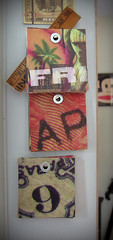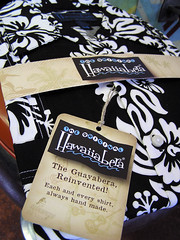A Digital Generation's Analog Chic
By JULIET CHUNG
When most people shop for a cellphone, considerations like aesthetics, size and features usually top the list. For most, the sleeker, the smaller and the more fully loaded the phone, the better.
But when Eugene Auh went trawling at eBay for a cheap cellphone last month, he searched for one with a decidedly anachronistic bent.
"I wanted the biggest cellphone I could find," said Mr. Auh, a 27-year-old investment manager in Philadelphia. His winning bid of $25.95 bought a Motorola DynaTac, a 1980's-era "brick" cellphone that fits more comfortably in a backpack than in a suit pocket.
Rather than subtracting from its charm, the phone's cumbersome size - it is roughly eight by two by three inches - is its main attraction, Mr. Auh said. Indeed, he plans to take the phone to work, to the gym and even to his nighttime haunts.
"Imagine this: I'll walk into a bar and ask for a girl's number, then break out my phone," he said. "How could you say no to that?"
While his attraction to digital relics may seem unusual, Mr. Auh is part of what appears to be a growing group of 20-somethings embracing yesterday's designs. These fans of retro technology are using ingenuity to find or fashion the perfect cellphones, gaming systems and computer cases - in effect ushering back a time they experienced only barely, if at all.
Take Ali Rahimi, 28, a graduate student at the Massachusetts Institute of Technology. Mr. Rahimi became so fed up last year with what he called the "impersonal, unthinking" nature of modern communication that he attached an old-fashioned handset to his cellphone. The result was a cellphone-handset whose receiver restored the deliberate nature of communication, he said.
"When you're talking to your grandma on an old-style handset, you're very aware of its presence," Mr. Rahimi said. "The handset has been going through about a hundred years of evolution in design and, pretty much for what they do, they have the perfect shape."
In contrast, he said, the rectangular design of modern cellphones encourages talking at the phone, rather than into it. "You just talk and the cellphone picks up the sounds," he said.
The easy, ironic social commentary that ownership of such a device allows caused Amanda McCorquodale to pay $36 for a Pokia handset in a kitschy avocado green. The Pokia line, an assortment of vintage handsets that plug into cellphones along the same creative lines as Mr. Rahimi's model, is produced in limited quantities in Britain and is sold at eBay.
Stating an opinion that might warm the hearts of an older generation, Ms. McCorquodale, 25, a textbook editor who lives in Brooklyn, said, "I just think people use their cellphones a ridiculous amount." The handset is an easy way of mocking the phone's ubiquity while also allowing her a quiet protest "against having to use a cellphone all the time, but not wanting to."
The popularity of retro technology simply reflects, in part, how sophisticated modern technology has become, said Steven Lubar, a Brown University professor of American civilization who specializes in the history of technology.
When the available technology converges at a certain performance threshold, Dr. Lubar said, consumers begin to base their choices on nontechnical considerations like fashion to express their identity. Thus the appeal of retro gadgets.
"There's something liberating about picking and choosing technological styles from the past as a means of self-expression," Dr. Lubar said by e-mail. "Perhaps there's a bit of self-conscious irony here, too."
For some, retro joy comes in bulkier, less technologically advanced packages. At eBay last year, John Henry Flood, a 21-year-old Harvard sophomore, bought the 1985 Nintendo Entertainment System along with the Atari 2600, a console that makes the Nintendo system appear positively cutting edge. Covered in wood-grain paneling and plastic molding, the first Atari 2600 made its debut in 1977 and was the first widely popular gaming system, used to play video games like Space Invaders and Asteroids.
Another reminder of its age is a switch that gives gamers the option to optimize color resolution for black-and-white televisions.
But the vintage nature of the machines means that games are cheap and easily grasped by a wide audience. Mr. Flood bought the first-generation consoles mainly so he could play video games with his college friends, who he said were more inclined to play low-tech games like Super Mario Brothers than to invest the time needed to play today's more complex games.
Then there is the "wow" factor.
"Everyone's like, oh my gosh, where'd you get these?" Mr. Flood said. While he also owns a Microsoft Xbox and a Sony PlayStation 2, the retro consoles see far more playing time in his dorm room, he said.
For those who prize the convenience of today's technology while preferring the look of their parents' gadgets, several manufacturers have stepped in with hybrid alternatives.
Polyconcept USA offers a line of retro turntables distinguished by the abundance of wood and vintage touches like analog radio dials. But closer inspection reveals discreet CD slots, light-emitting-diode displays and built-in stereo speakers.
The subtleness of the modern amenities is part of a larger effort to evoke the look of bygone eras, said Brian Tompkins, Polyconcept's national accounts manager for electronics. For example, the product teams that oversaw the design of the RCA Newport Turntable fussed over the smallest details - "down to the control knobs and the brass faceplates that have representative etchings and designs," Mr. Tompkins said.
The Victrola-style turntable even has a functioning metal horn, as well as a decorative crank (the turntable is AC-powered).
And for something retro to put into those CD slots, Verbatim has come out with a series of inky-black recordable compact discs that look like miniature 45-r.p.m. vinyl records, complete with the discs' grooved look and brightly colored labels.
A more homespun effort is being undertaken by Andrew Fader, 15, and Karthik Seshan, 16, two high school students in Briarcliff Manor, N.Y. The pair recently founded Facade Computer, which builds modern computers into retro casings.
Consumers can order desktops or laptops while customizing specifics like the size of the hard drive and memory. After ordering the components wholesale - Mr. Fader estimates that such customized computers would cost $500 to $1,000 depending on the specifics - the students build the parts into the customer's retro casing of choice.
"The idea is to get the aesthetics of older technology and mix it with the functionality of newer technology," Mr. Fader said.
"Companies today like to make you think that cases that are sleek and gray and beige look good, but they don't, really. It's things that look more natural, that go with your house and are made of wood, that are more appealing."
The pair's first conversion, at their Web site (facadecomputer.com), is of a computer built into the mahogany casing of a 1937 Emerson 215 tube radio that they rescued from Mr. Fader's attic. Other possibilities for casings include old briefcases, typewriters and televisions. "The idiom 'one man's trash is another man's treasure' really applies here," Mr. Fader said. "There's a lot of stuff that people really don't realize the value of."
The rebellion against today's gadgets may only go so far, though. For those who prefer vintage technology, a major drawback is the hassle of dealing with technology that is, well, vintage.
For Mr. Flood, that means blowing the dust out of old Nintendo game cartridges. Today's games, which come on CD's, do not require such exertions.
Mr. Auh, meanwhile, is holding off on his romantic overtures until he finds a service provider that can support his antiquated cellphone. But once he does, the women of Philadelphia will need to act quickly, Mr. Auh warned.
"This cellphone only stores nine numbers, ladies," he said, "so it's first come, first served."
Subscribe to:
Post Comments (Atom)






























































No comments:
Post a Comment